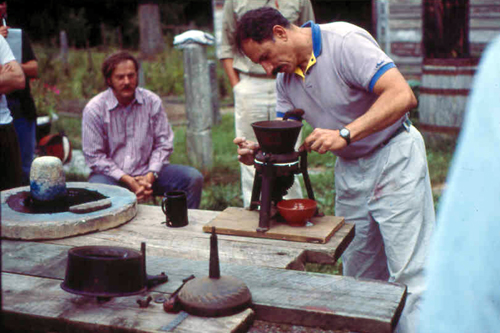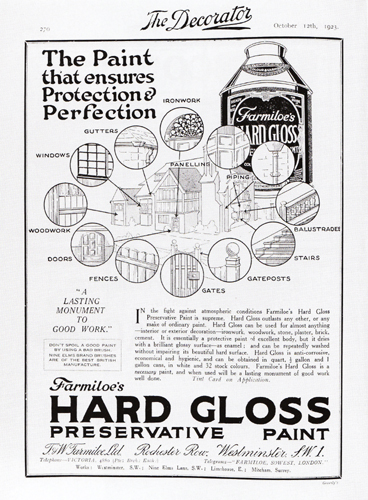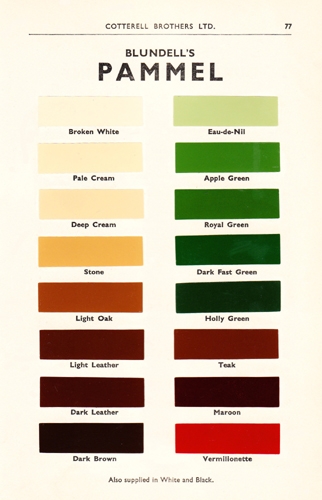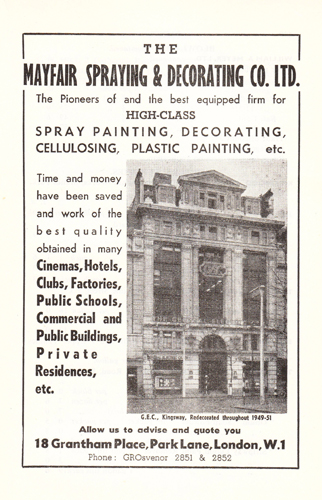
Part I – The General Nature of Paints
Towards the end of 1941 the Minister of Works established a series of committees to investigate and report on the problems likely to be faced in post-war building. ‘The Painting of Buildings Committee’ was convened in January 1946 by the Paint Research Association with the object of reviewing practice in paint manufacture and painting technique. Amongst other things it was charged with examining the essential needs of buildings during the first three years of peace and the technical properties of paint products.
A booklet was produced in 1944 and this was revised in August 1946.
Part 1 deals with the three main classes of paints – Oil Paints, Cellulose Paints and Water Paints – in a very clear and succinct manner. As a potted guide to what was available at the time it is excellent. In this post we shall consider what was written about the first two types of paints. Water Paints will be considered in a later post.

The pamphlet first explains how oil paints are made:
Preparation of Oil Paints
The usual method of preparing oil paints is to grind the solid ingredients into a stiff paste with the drying oil, and subsequently thin this down to the consistency required for application with more oil, with the addition of thinner and driers according to the type of paint required. Until recent years it was the general practice for the makers to supply this stiff paste to be thinned down by the user as required. This practice is still employed to some extent, but most paints are now supplied mixed ready for use.
It then goes on to describe the difference between the various types of oil paint. For example:
The process of making Oil Gloss:

Oil Gloss Paints1
For finishing coats a high gloss is usually required. This is obtained by thinning down the paste with more drying oil and the necessary driers, only sufficient thinner being added to give the paint satisfactory working qualities.
Contrast this with that for Hard Gloss:

Hard Gloss Paints
The quality of the finish obtainable with paint made with the type of medium described above is limited by the fact that such paints do not flow over the surface after application sufficiently to smooth out the ridges left by the brush. Various modifications in the composition of the medium have been introduced in modern practice for the purpose of improving this property of the paint. One method is to heat the drying oil before use until it thickens to the consistency of treacle; paints made with oil treated in this way flow to a much greater extent after application, with the result that the brush marks are eliminated and a more brilliant gloss obtained.
A somewhat similar result is obtained by the addition of varnish to the medium; this has the effect of making the paint dry with a harder surface as well as a better gloss.
A further development became possible a few years ago with the adaptation of the synthetic resins used in the plastics industry for the preparation of paint mediums. This enabled new types of paint to be made which dry comparatively quickly with a hard surface and exceptional gloss. By combining these methods in various ways a wide range of full gloss paints for finishing coats is obtainable. Most manufacturers supply such specially prepared paints under their own proprietary names, but the description “hard gloss paint” has come into general use to include all such types of paint, which have a gloss superior to that obtainable with the ordinary linseed oil medium and in many cases dry more rapidly.
The synthetic products known as ‘drying oil modified alkyd resins‘ are especially useful for the preparation of these paints. These synthetic vehicles enable full gloss paints of marked durability to be produced. This property, taken in conjunction with the fact that an appreciable economy in linseed oil is effected by their use, and that the materials required for the production of the alkyd resins are home-produced, renders them especially suitable for post-war use.
The above explains very well the limitations of the traditional oil paint and just why the alkyd resins were introduced. At the same time it tries to clear up one of the confusions that had developed as a result of marketing:

Enamels2
The term enamel was originally introduced into the paint industry to describe a paint made with heat-treated linseed oil (‘stand oil‘) with or without resins. The description ‘enamel’ or ‘enamel paint’ is very loosely used at the present time, but generally implies a superior quality of paint made on similar lines to a hard gloss paint.
Cellulose Paints3
We are told that these differed from oil paints in drying entirely by the evaporation of a solvent, no chemical change being involved. The principal constituent of the medium is usually nitro-cellulose, derived from cellulose (cotton) by chemical treatment.
The fact that the drying is entirely due to the evaporation of the solvent used in preparing the medium means that the paint film retains its solubility, and unless such paints are applied by spraying there are difficulties in application. As the decoration of buildings by spraying is subject to severe limitations, and brush application, except for small articles, is impossible cellulose paints are seldom used on buildings. In practice, they are mainly used for the decoration of prefabricated fittings and in the motor-car and aeroplane industries.
To be continued…
Notes
1 For more on Gloss Paints
2 For more on Enamel Paints
3 For more on Cellulose Finishes
View Larger Map












No comments yet. Be the first!